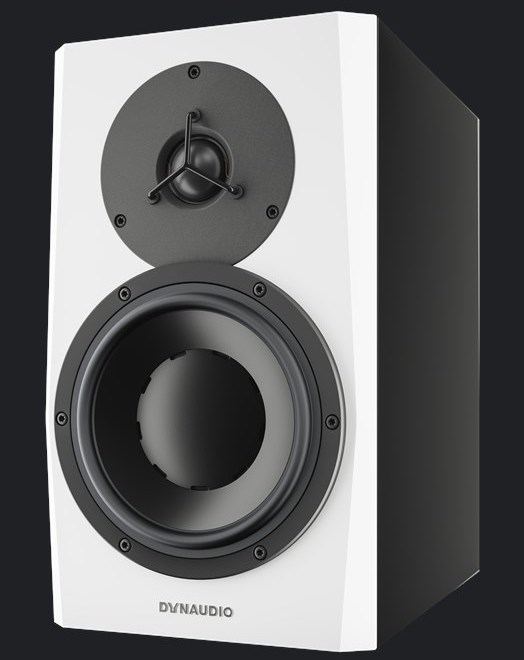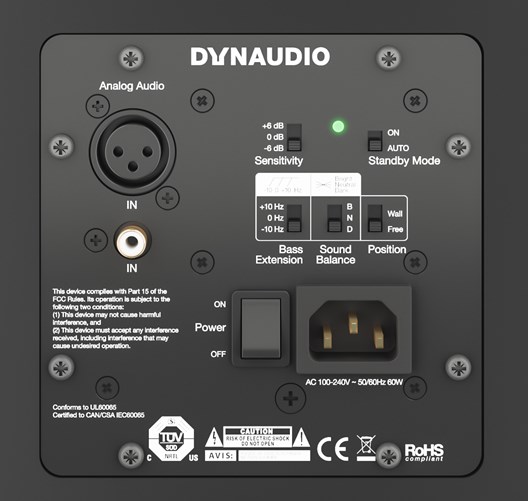New Gear Review: LYD 7 Nearfield Monitors by Dynaudio

The LYD family sports a sleek new look, while still paying homage to its predecessors, the BM mkIII series.
The new LYD range of monitors is the latest offering from Danish loudspeaker manufacturer, Dynaudio.
The LYD family follows in the footsteps of the acclaimed BM mkIII series in form and function. However, enough changes have been implemented outside of its attractive new aesthetic design for this speaker line to stand apart from its predecessors.
Features
The LYD 7 model, which I tried out for this review, is a bi-amplified nearfield monitor that sports a 7” woofer and a 28mm soft dome tweeter. Both of these drivers are manufactured in Dynaudio’s factory in Denmark, which is also where the speakers are assembled—by hand.
The LYD 7 is just one of three different speakers in the LYD family. In addition to this model, Dynaudio offers versions with a 5” woofer (LYD 5) an 8” woofer (LYD 8), and most recently, the tri-amplified LYD48.
On the back of the speaker you will find connections for XLR and RCA inputs, trim knobs, a “Position” switch, bass extension switch, “Sound Balance” switch, and a Standby Mode that conserves energy when the speaker does not detect audio.
One of the more interesting points of the LYD 7—and entire LYD range for that matter—is the “Position” switch. This control allows you to tailor the monitor to your needs by shifting the response of the speaker, depending on how close it is to a wall. The “Wall” setting is used when the speakers are within 50cm of a wall, and the “Free” setting is used when the speaker is free-standing. Ultimately, this feature allows the speakers to limit some of the undesired artifacts that result from being placed too close to a wall, and perform in a way close to how they were intended to sound in a less-compromised environment.

A detailed view of the back panel of the LYD 7, showing its unique Sound Balance and Position switches, among other useful features.
Additionally, Dynaudio has included a “Sound Balance” switch. It performs a familiar task, but in a novel way.
This switch (which has three positions: Dark, Bright, and Neutral) applies a tilt filter to the response of the monitor to brighten or darken the sound depending on the room.
Many conventional monitors feature shelving adjustments for these areas instead, but Dynaudio’s addition of this subtle tilt filter in place of these shelves creates similar results while still preserving as much linearity in the speaker as possible.
In Use
My first impression out of the box was that the LYD 7s have a ton of definition in the midrange. While certainly not entry-level (priced at $669 per speaker), the LYDs still manage to have plenty of nuance in this area for such a low cost. While many speakers geared towards budget-conscious users tend to lack clarity in the midrange, the LYD 7s excel beautifully here and should be commended for that feat alone.
But that’s just the beginning. Dynaudio’s claim of low volume precision reigns true. While using the speakers at a volume low enough to where I could still hold a conversation, I was able to pick out their nuanced response with little to no tradeoff for volume. Even the low-end response remained intact without sounding muddy at quiet volumes.
Speaking of low end, the included “Position” switch was an especially useful new feature in my room. Since my setup has the speakers placed very close to a wall, the inclusion of this switch was a major selling point in and of itself. The low end artifacts produced by rear-ported speakers can be a pain to overcome when working with a tight setup, but it’s apparent that Dynaudio has made an effort to ensure that the LYD 7s can not only fit into a restrictive space, but excel in it.
To Be Critical
There is very little to fault the LYD 7s with, especially considering the price point. If I had to find a shortcoming, it would be that the speakers (within my particular setup) sounded a bit rolled off in the top end compared to other options. Referencing on my trusted Beyerdynamic DT770 Pro Headphones, I found my mixes to be coming out just a tad too bright (and I do mean just a tad).
Ultimately, this complaint is more to do with learning a new speaker and less to do with an actual fault in the speaker itself. Not to mention, the Sound Balance switches on the back could easily compensate for this slight de-emphasis of the top end.
Summing it Up
The Dynaudio LYD 7s bring a whole lot to the table at a price of $669 per speaker. Unsurprisingly, the LYD 7 does justice to the legacy of the BM mkIII, while adding enough new features to make the speaker stand out on its own.
Dynaudio has delivered on all of the claims made through their marketing. The clarity in the midrange, the flat response across different volumes, and the brilliant addition of the “Position” switch are just a few of the many things that make these speakers a stellar option for users operating within the $700-per-speaker budget range.
Altogether, Dynaudio has managed to create a speaker that delivers pro-level precision at a mid-level price point. Much like the BM mkIIIs, I wouldn’t be surprised to see sets of LYDs popping up in studios across the country. This sleek and modern speaker is innovation at its finest and is an absolute joy to work on.
Jacob Roach is a writer, producer, and engineer from St. Louis, Missouri.
Please note: When you buy products through links on this page, we may earn an affiliate commission.






